Sun-Fading and UV-Glass Experiment (A Case Study)
Introduction
Have you ever wondered just how damaging sunlight exposure (direct, or even indirect) can be to your precious Japanese woodblock prints over time?? And, at the same time, have you ever framed or considered framing some of your prints using the expensive and highly touted "protective UV-shielding glass"--but, at the same time wondered, "Just how much "protection" does this glass really afford?" Well, so have we.....
Using simple logic, consider for a moment the perhaps ill-founded claims touted by the manufacturers of "UV-glass" who recommend that we use their products to "protect" our artwork. Despite their claims, the simple fact remains that in order for you to "see" your print, light (and lots of it!!) must get through to the print's surface and then bounce back to your eyes. Because that's what you see in terms of your print's colors--reflected light. So, while although "UV-glass" may indeed "shield out 97 percent of the harmful UV-rays," what about all the OTHER visible spectrum of light which then still reaches your print's surface? Just how damaging are they? .....Sadly, here we suspect that many art lovers have been lulled into a state of complacency and thusly adopted a false sense of security in their reliance in and use of "UV-filtering glass."
The Set-Up
With these questions and concerns in mind, as you can see in the pictures just below we've devised a simple experiment that has now been underway for the past 4 months. Hopefully, in doing this simple experiment, we will perhaps be able to cut through some of these promises made and get to the bottom of this important issue. For this research we've selected two prints--one a c1880's Meiji era print; and a newer c1980's modern ukiyo-e "re-strike" (comparable with its pigments with many LATER, but not all, shin-hanga prints)--and mercilessly exposed them directly to the daily afternoon sunlight beginning this past February (2002). Each print has been divided into four "quarters," with the first two "quarters" of each print exposed simultaneously to the daily sun beginning February 1st. The far left exposed quarter of each print is "protected" by "UV-glass," while the adjacent second quarter is under only "regular glass."
At the beginning of this experiment, our plan has been to expose the hidden "third quarter" of each print after either 3 or 4 months exposure to Oregon's weak and infrequent winter and often cloudy spring sunshine, comparing both print's unexposed and unfaded "third quarters" at that time then to the assumedly already somewhat faded earlier quarters. At that point, our experiment would then simply continue on into the longer, harsher summer days of daily sunlight with three-quarters of each print enduring continued punishment. The final "forth quarter" of each print would always remain protected from the sunshine, serving as a "test control" which would thusly provide the basis for all "before" and "after" comparisons.
Admittedly this is certainly much harsher treatment than any one of us would ever subject our own prints to in real time. However, by doing so, we're attempting to demonstrate via an accelerated 8 months of exposure the accumulated damage that the private collector might otherwise expect to occur over perhaps 5, 10 or 15 years of typical household exposure.
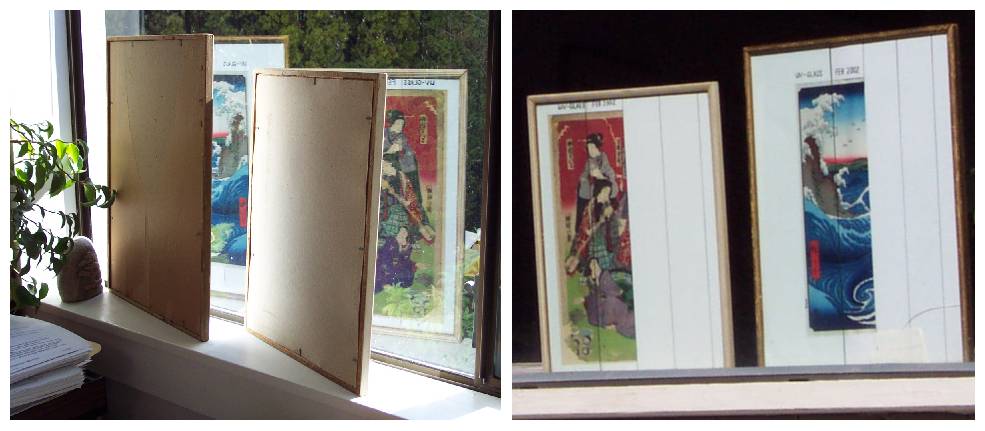
The Set-Up: Inside .....and Outside
Our "Half-Way Point" Examination
Finally then, on May 31, after 4 months of exposure to "Oregon's weak winter sunshine," we removed our two test prints from their windowsill and opened them up for our first examination and comparison.
The Meiji Era Print--After 4 Month's Exposure
What appeared in real time to have been a somewhat noticeable amount of fading to the much older Meiji (c1880's) print was indeed confirmed upon its opening. In fact, the results were somewhat shocking as you can see just below. The original bright red and green background colors had become noticeably faded; and the dark purple kimono (lower left) suffered even more, turning to a very pale shade of its original color. Even the two originally yellow "title cartouches" (left and left/center) had now become a nearly colorless white.
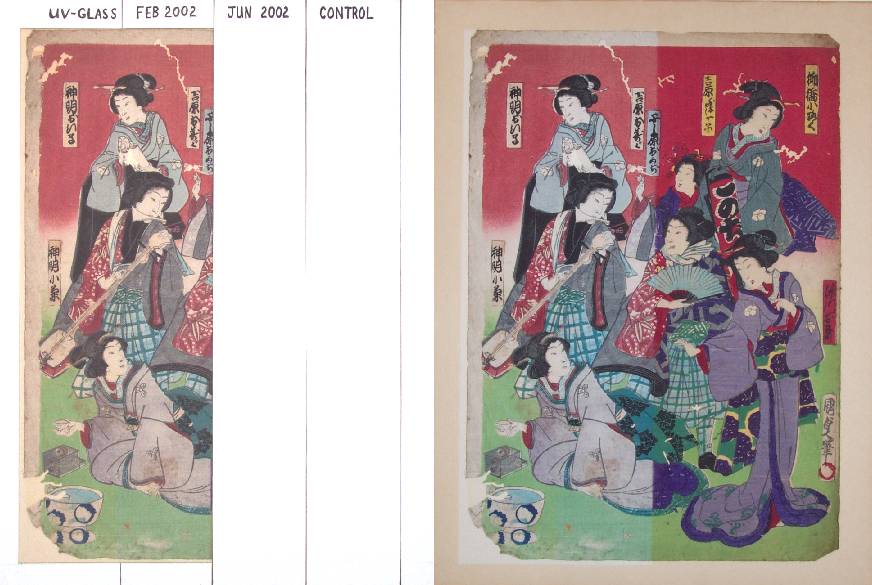
Exposed 2 Quarters of Print .....Entire Print
However, even MORE shocking was the nearly complete lack of protection provided to the print by the 2 1/2 inch wide vertical strip of "UV-glass" which was supposedly "protecting" the leftmost quarter of our print. Indeed, only the faintest "vertical" line of difference can be detected upon close examination--and this observation was echoed when my wife candidly asked, "Which side (quarter) had the "UV-protection??" Clearly, the "UV-filtering glass" was of little value in protecting our print.
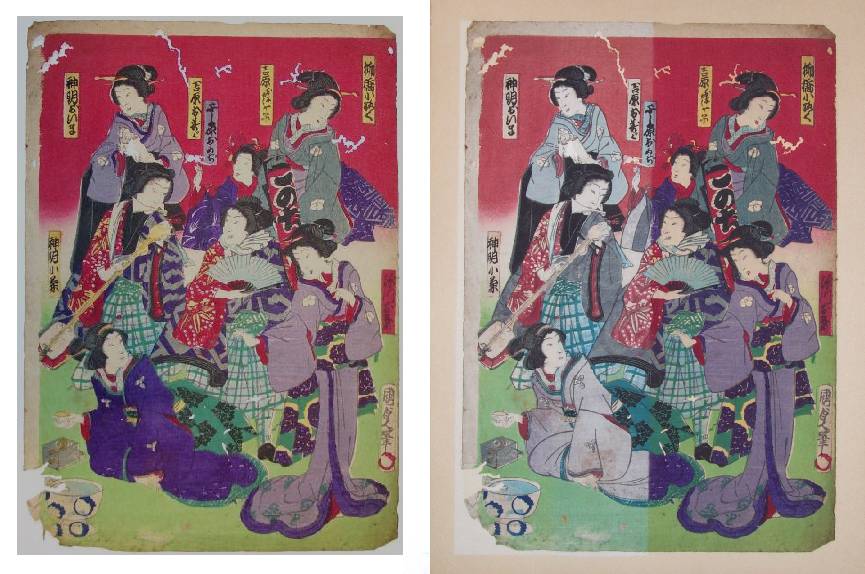
Before..... .....and After 4 Months
The Newer "Ukiyo-e Re-strike" Print--After 4 Month's Exposure
The opening and subsequent close examination of our second print, a c1980's ukiyo-e "re-strike" by Uchida Publisher (of Hiroshige's famous "Giant Whirlpools at Naruto"), yielded much different results. Virtually no degree of noticeable fading was observed in this largely "blue" print, even though it was exposed to the IDENTICAL daily sun exposure of the Meiji Era print above. Only the faintest vertical "fade line" can be seen in the exact center of the print--just at the right edge of the mountain one can see where the red is slightly faded; and directly above this a faint "fade line" can be seen extending vertically into the blue sky.
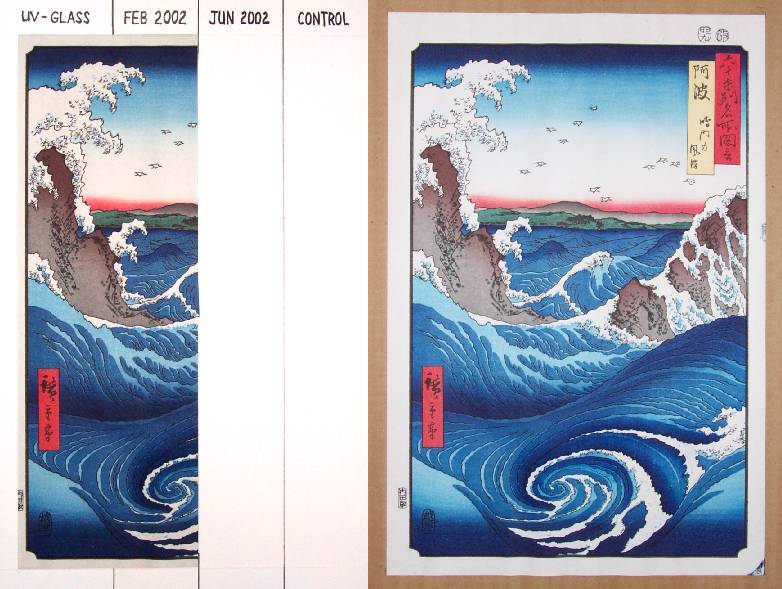
Exposed 2 Quarters of Print .....Entire Print
Clearly then, our assumed conclusion is that the newer pigments used in modern day "re-strike" prints (but perhaps NOT in the case of earlier shin hanga prints) are apparently much more "colorfast" than the pigments used during Meiji Japan. However--and again we wish to emphasize this point--NO 1920's/30's/40's shin hanga prints were studied during this experiment, so broad conclusions regarding earlier shin hanga era pigments should not be made.
Here also, perhaps little can be really said with respect to the "protection" provided by the UV-glass, since the apparent "colorfastness" of this print after 4 months of exposure has yielded little observable change. Perhaps more fading will be noted over the coming harsher summer months, we'll have to just wait and see.
Interim Conclusions and Comments
At this point, let us first remind the reader that this experiment is still a "work in progress," and as such we are only now at its halfway point. We will now continue to let nature take its course--at a pace that should now accelerate as we move into the much sunnier and longer days of summer.
That said, it is still prudent at this point to very thoughtfully consider the following two points. First, considerable light exposure damage has already occurred to the Meiji era print after only 4 months of exposure; and that our single modern ukiyo-e "re-strike" test print's pigments may well be more colorfast that many others. (Also remember, much of Oregon's past 4 winter months have been shrouded in clouds and often without sunshine.) Second, our experience so far seems to strongly indicate that VERY LITTLE protection is provided by the highly touted "UV-filtering glass" in which so many of us have come to perhaps ill-advisedly place our trust.
Some Common Sense Suggestions
At this point, it is additionally prudent to advise the collector to eliminate--or certainly minimize--the light exposure to his/her print collection. At the very least, prints which are chosen for wall display should NEVER be hung onto walls that receive harsh, direct sunlight. Perhaps a north-facing wall or windowless hallway would be a safer choice. Another consideration might be to simply avoid putting one's most valuable or more rare prints onto the wall. In any case, exposure to light should be minimized.
Another possibility might be to "rotate" one's prints after a few weeks of exposure. This is easily accomplished by having a few "easy-open" frames build which then allow the collector to simply open up the backside to remove and replace these prints on a regular basis. This system would also give the collector the added advantage of being able to visually "enjoy" more of his/her collection.
Finally, we also know of one collector who has "duplicated" a number of expensive original edition (c1850's) Hiroshige prints in his collection with much later printed "re-strikes" of the same images. The true originals are kept in his safe and brought out occasionally for "hands-on" enjoyment, while the look-alike "re-strikes" costing one-tenth as much remain up as framed prints on his walls.
Stay Tuned.....
We'll be reporting back in another 4 months (at the end of September) with our final results.
Our Final "End-Point" Examination
Recently on September 30, after 8 total months of continuous daily exposure to Oregon's sunshine, we removed our two test prints from their windowsill and opened them up for a final examination and comparison, the results of which we report just below.
The Meiji Era Print--After a Total of 8 Month's Exposure
Recalling the considerable amount of fading which had occured to the much older Meiji (c1880's) print even during the previous "less sunny" springtime months, we were not at all surprised by the additional fading which had occurred to this print. The results were consistent with what had been observed earlier in this experiment--the original bright red and green background colors had now become even more severly faded; and, as before, the dark purple kimono (now lower right) suffered even more, turning to a very pale shade of its original deep purple color. And as before, now the three of the four originally yellow cartouches (left, left center, and right center) had now become a nearly a colorless white. Due to the harsh daily summer sun of the previous 4 months, BOTH of the middle/unprotected quarters now appear nearly identically faded--irrespective of whether exposed to 8 months of sunlight (left center quarter) or "only" 4 months (as in the case of the right center quarter).
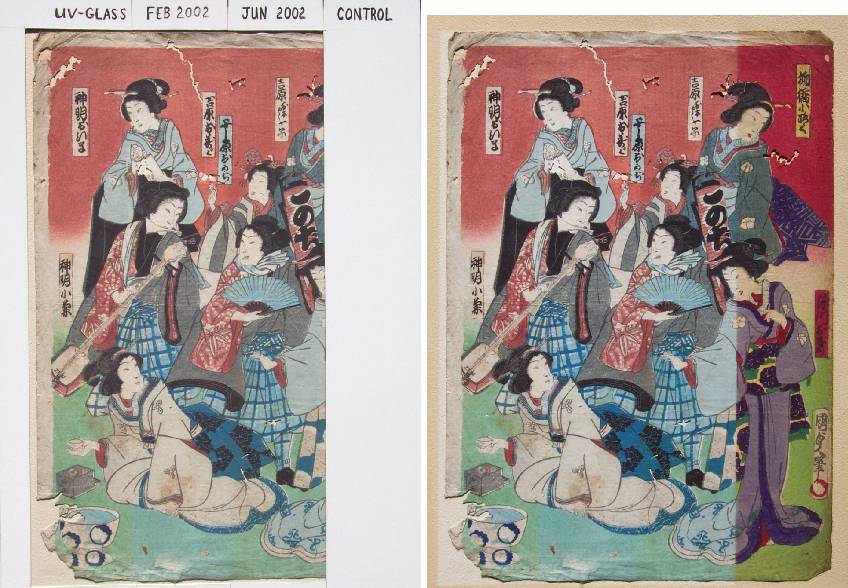
Exposed 3 Quarters of Print .....Entire Print
However again, MOST shocking was the nearly complete lack of protection provided by the 2 1/2 inch wide vertical strip of "UV-glass" which was covering and "protecting" the leftmost quarter of our print. Indeed, only the faintest "vertical" line can be seen, where a slight degree of lessor fading is seen in the lower green area. Althought certainly not scientific, perhaps it can be said that the UV-sheilding glass reduced fading by only about 10 percent--if that.
The Newer "Ukiyo-e Re-strike" Print--After a Total of 8 Month's Exposure
As before, the final examination of our second modern-day "re-strike" print by Uchida Publisher again yielded results that were in striking contrast with the badly faded Meiji print seen above. Despite 8 continuous months of damaging exposure to harsh sunlight, still no readily noticeable degree of fading occured to this largely "blue" print. One can only conclude that, at least apparently in the case of THIS 1980's Uchida print, the pigments used for printing were unexpectely colorfast. Again, only two faint vertical "fade line" can be seen to the thin horizontal band of "red sky"--one below the wave (where the UV-glass provided "some" protection) and the other to the right below the yellow cartouche (where covered by the protective matting).
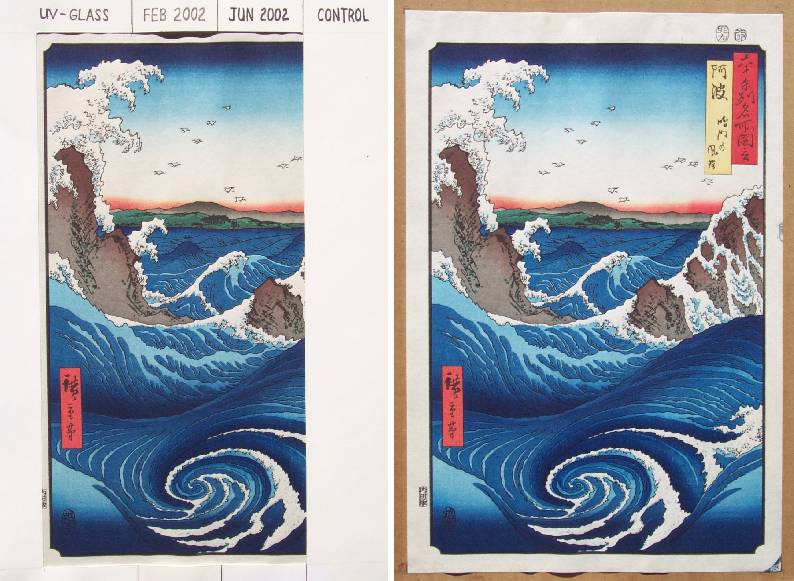
Exposed 3 Quarters of Print .....Entire Print
A Word of Caution....
Here we wish to stress that although THIS "shin hanga" print appears to have been printed using fairly colorfast colors, we would strongly caution the reader from making this "assumption" with respect to the colorfastness of other (earlier) "shin hanga" prints.
Again note--NO earlier 1920's/30's/40's "shin hanga" prints were studied during this experiment, so broad conclusions of the colorfastness of earlier "shin hanga" era pigments (and of these typically more valuable, earlier prints) should NOT be made or drawn from this limited experiment.
Final Conclusions and Comments
Although not precise or scientific, we hope that this simple and easily understandable experiment has PROVEN to the reader that "UV-shielding glass" offers at best a very minimal degree of protection from sun-fading exposure. Indeed, it now seems obvious to us that collectors who rely on "UV-shielding glass" to protect their prints are being seriously mislead by marketing claims provided by these glass manufacturers.
Clearly, the best overall advice we can now offer to collectors is to minimize (or entirely eliminate) the light exposure which meets his/her print collection. As suggested previously, prints on display should NEVER be hung onto walls exposed to direct sunlight. Any wall display locations should thusly be selected with an eye towards minimizing sun or other continuous light exposure.
To those readers who may have an interest in pursuing this matter of print fading a bit further, we invite them to read Marc Kahn's short but interesting article titled "Color Stability") at his always interesting Shotei.com website. There also, additional references are given where the reader can pursue the issue of fading in a more purely scientic manner.
For yet additional discussions regarding the "rate of fading" and "UV-filtering," we encourage our readers to see John Fiorillo's treatise titled "Will UV glass protect my prints from fading?"
Bottomline--DO NOT RELY ON "UV-shielding glass" to protect your collection.
(c) Thomas Crossland and Andreas Grund, June 2002/October 2002
Gallery
Terms
Ordering
About Us
We Buy Prints
Library






